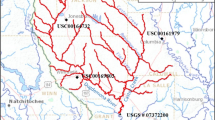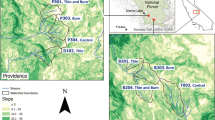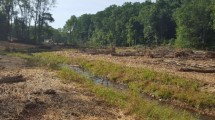Abstract
We examined changes in suspended-sediment yields (SSY) after a 50 % strip thinning in headwater streams draining a Japanese cedar (Cryptomeria japonica) and cypress (Chamaecyparis obtusa) plantation forest. We applied a paired-catchment analysis to treated (K T : 17.1 ha) and control (K C : 8.9 ha) catchments. Annual suspended-sediment yield (SSYan) in the prethinning period in the K T and K C catchments was 110.0 and 142.1 kg/ha per year. For the postthinning period, SSYan in the K T catchment became 5055.6 kg/ha per year, whereas that in the K C catchment increased 893.2 kg/ha per year. The paired-catchment analysis revealed that SSY in the K T catchment increased 17.0-fold compared with the prethinning period. However, the dominant hysteresis pattern remained clockwise in both pre- and postthinning periods. Sequences of large storm events in the postthinning period elevated SSY in both catchments. Increase in suspended sediment in the K T catchment was associated with the combined impacts of thinning and sequences of storm events during the period of thinning operation.




Similar content being viewed by others
References
Abe T, Mizugaki S, Toyabe T, Maruyama M, Murakami Y, Ishiya T (2012) High range turbidity monitoring in the Mu and Saru river basins: all-year monitoring of hydrology and suspended sediment transport in 2010. Itn J Eros Contr Engr 5:70–79
Anderson B, Potts DF (1987) Suspended sediment and turbidity following road construction and logging in western Montana. Water Resour Bull 23:681–690
Barreto P, Amaral P, Vidal E, Uhl C (1998) Costs and benefits of forest management for timber production in eastern Amazonia. Forest Ecol Manag 108:9–26
Beschta RL (1978) Long-term patterns of sediment production following road construction and logging in the Oregon Coast Range. Water Resour Res 14:1011–1016
Bosch JM, Hewlett JD (1982) A review of catchment experiment to determine the effect of vegetation changes on water yield and evapotranspiration. J Hydrol 55:3–23
Brocca L, Melone F, Moramarco T (2008) On the estimation of antecedent wetness conditions in rainfall–runoff modeling. Hydrol Process 22:629–642
Brown GW, Krygier JT (1971) Clear-cut logging and sediment production in the Oregon Coast Range. Water Resour Res 7:1189–1198
Brown AE, Zhang L, McMahon TA, Western AW, Vertessy RA (2005) A review of paired catchment studies for determining changes in water yield resulting from alterations in vegetation. J Hydrol 310:28–61
Christie T, Fletcher WK (1999) Contamination from forestry activities: implications for stream sediment exploration programs. J Geochem Explor 67:201–210
Douglas I, Spencer T, Greer T, Bidin K, Sinun W, Meng WW (1992) The impact of selective commercial logging on stream hydrology, chemistry and sediment loads in the Ulu Segama rainforest, Sabah. Philos T Roy Soc B 335:397–406
Douglas I, Greer T, Bidin K, Spilsbury M (1993) Impacts of rainforest logging on river systems and communities in Malaysia and Kalimantan. Global Ecol Biogeogr 3:245–252
Dung BX, Gomi T, Miyata S, Sidle RC, Kosugi K, Onda Y (2012) Runoff responses to forest thinning at plot and catchment scales in a headwater catchment draining Japanese cypress forest. J Hydrol 444–445:51–62
Dung BX, Hiraoka M, Gomi T, Onda Y, Kato H (2015) Peak flow responses to 50 % strip thinning in a forested headwater catchment with nested observations. Hydrol Process. doi:10.1002/hyp.10720
Ferguson RI, Stott TA (1987) Forestry effects on suspended sediment and bedload in the Balquhidder catchments, Central Scotland. Earth Env Sci T R So 78:379–385
Ferguson RI, Grieve IC, Harrison DJ (1991) Disentangling land use effects on sediment yields from year to year climatic variability. Sediment and stream water quality in a changing environment: Trends and explanation (Proceedings of the Vienna Symposium, August 1991) Itn Assoc Hydrol S Publ 203
Forestry Agency (2008) Annual report on trends in forests and forestry. The Ministry of Agriculture, Forestry and Fisheries, Tokyo, p 31
Foster IDL, Millington R, Grew RG (1992) The impact of particle size controls on stream turbidity measurements; some implications for suspended sediment yield estimations. Itn Assoc Hydrol S Publ 201:51–62
Gippel CJ (1989) The use of turbidimeters in suspended sediment research. Hydrobiologia 176(177):465–480
Gippel CJ (1995) Potential of turbidity monitoring for measuring the transport of suspended solids in streams. Hydrol Process 9:83–97
Gomi T, Moore RD, Hassan MA (2005) Suspended sediment dynamics in small forest streams of the Pacific Northwest. J Am Water Resour Assoc 41:877–898
Gomi T, Sidle RC, Ueno M, Miyata S, Kosugi K (2008) Characteristics of overland flow generation on steep forested hillslopes of central Japan. J Hydrol 361:275–290
Gomi T, Asano Y, Uchida T, Onda Y, Sidle RC, Miyata S, Kosugi K, Mizugaki S, Fukuyama T, Fukushima T (2010) Evaluation of storm runoff pathway in steep nested catchments draining a Japanese cypress forest in central Japan: hydrometric, geochemical, and isotopic approaches. Hydrol Process 24:550–566
Grant GE, Wolff AL (1991) Long-term patterns of sediment transport after timber harvest, western Cascade Mountain, Oregon, USA. In: Sediment and stream water quality in a changing environment: trends and explanation. IAHS Publication 203, Wallingford, Oxfordshire, United Kingdom: pp 31–40
Herschy RW (1985) Streamflow measurement. Elsevier Applied Science Publication
Hicks DM, Basil Gomez B, Trustrum NA (2000) Erosion thresholds and suspended sediment yields, Waipaoa River Basin, New Zealand. Water Resour Res 36:1129–1142
Hiep SH (2014) Evaluating runoff and sediment yield from skid trails in a forested headwater catchment. Unpublished master thesis, University of Agriculture and Technology, Tokyo, p 36
Hotta N, Kayama T, Suzuki T (2007) Analysis of suspended sediment yields after low impact forest harvesting. Hydrol Process 21:3565–3575
Iwamoto J (2002) The development of Japanese forestry. In: Iwai Y (ed) Forestry and the forest industry in Japan. UBC Press, Vancouver, pp 3–9 (chapter 1)
Johnson RC (1993) Effects of forestry on suspended solids and bedload yields in the Balquhidder catchments. J Hydrol 145:403–417
Kasran B (1988) Effect of logging on sediment yields in a hill Dipterocarp forest in Peninsular Malaysia. J Trop For Sci 1:56–66
Kasran B, Nik AR (1994) Suspended sediment yields resulting from selective logging practices in a small watershed in Peninsular Malaysia. J Trop For Sci 7:286–295
Leeks GJL (1992) Impact of plantation forestry on sediment transport processes. In: Billi P, Hey RD, Thorne CR, Taconi (eds) Dynamics of gravel bed rivers. John Wiley and Sons, New York, pp 651–670
Lewis J, Mori SR, Keppeler T, Ziemer RR (2001) Impacts of logging on storm peak flows, flow volumes and suspended sediment loads in Caspar Creek, California. Water Sci Appl 2:85–125
López-Tarazón JA, Batalla RJ, Vericat D, Francke T (2009) Suspended sediment transport in a highly erodible catchment: the River Isábena (Southern Pyrenees). Geomorphology 109:210–221
Malmer A (1990) Stream suspended sediment load after clear-felling and different forestry treatments in tropical rainforest, Sabah, Malaysia. Int Assoc Hydrol Sci Publ 192:62–71
Martin FJEB, Morris AJ (1998) Non-linear principal components analysis for process fault detection. Comput Chem Eng 22:S851–S854
Megahan WF (1972) Logging, erosion, sedimentation–are they dirty words? J Forest 70:403–407
Miller JR, Sinclair JT, Walsh D (2015) Controls on suspended sediment concentrations and turbidity within a reforested, Southern Appalachian headwater basin. Water 7:3123–3148
Minella JPG, Merten GH, Reichert JM, Clarke RT (2008) Estimating suspended sediment concentrations from turbidity measurements and the calibration problem. Hydrol Process 22:1819–1830
Mizugaki S, Nanko K, Onda Y (2010) The effect of slope angle on splash detachment in an unmanaged Japanese cypress plantation forest. Hydrol Process 24:576–587
Nagatsuka Y, Gomi T, Hiraoka M, Miyata S, Onda Y (2014) Infiltration capacity and runoff characteristics of a forest road. J Jpn For Soc 96:315–322 (in Japanese with English abstract)
Nakamori Y, Takii T, Miura S (2012) Variation in fine earth, sediment, and litter movement with different forest management practices on a steep slope in a Chamaecyparis obtuse plantation. J Jpn For Soc 3:120–126 (in Japanese with English abstract)
Nanko K, Mizugaki S, Onda Y (2008) Estimation of soil splash detachment rates on the forest floor of an unmanaged Japanese cypress plantation based on field measurements of throughfall drop sizes and velocities. Catena 72:348–361
Nanko K, Onda Y, Kato H, Gomi T (2015) Immediate change in throughfall spatial distribution and canopy water balance after heavy thinning in a dense mature Japanese cypress plantation. Ecohydrology. doi:10.1002/eco.1636
O’Connell PF, Brown HE (1972) Use of production functions to evaluate multiple use treatments on forested watersheds. Water Resour Res 8:1188–1198
Oeurng C, Sauvage S, Perez JMS (2010) Dynamics of suspended sediment transport and yield in a large agricultural catchment, southwest France. Earth Surf Process Landf 35:1289–1301
Old GH, Leeks GJL, Packman JC, Smith BPG, Lewis S, Hewitt EJ, Holmes M, Young A (2003) The impact of a convectional summer rainfall event on river flow and fine sediment transport in a highly urbanized catchment: Bradford, West Yorkshire. Sci Total Environ 314–316:495–512
Onda Y, Gomi T, Mizugaki S, Nonoda T, Sidle RC (2010) An overview of the field and modelling studies on the effects of forest devastation on flooding and environmental issues. Hydrol Process 24:527–534
Reid LM, Dunne T (1984) Sediment production from forest road surfaces. Water Resour Res 20:1753–1761
Richey JE, Meade RH, Salati E, Devol AH, Nordin CF Jr, dos Santos U (1986) Water discharge and suspended sediment concentrations in the Amazon River: 1982–1984. Water Resour Res 22:756–764
Rodgers M, Connor MO, Robinson M, Muller M, Poole R, Xiao L (2011) Suspended solid yields from forest harvesting on upland blanket peat. Hydrol Process 25:207–216
Seeger ME, Beguería MP, Arnáez S, Martí JC, García RJM (2004) Catchment soil moisture and rainfall characteristics as determinant factors for discharge/suspended sediment hysteretic loops in a small headwater catchment in the Spanish Pyrenees. J Hydrol 288:299–311
Sidle RC, Tsuboyama Y, Noguchi S, Hosoda I, Fujieda M, Shimizu T (2000) Stormflow generation in steep forested headwaters: a linked hydrogeomorphic paradigm. Hydrol Process 14:369–385
Sidle RC, Sasaki S, Otsuki M, Noguchi S, Nik AR (2004) Sediment pathways in a tropical forest: effects of logging roads and skid trails. Hydrol Process 18:703–720
Sidle RC, Hirano T, Gomi T, Terajima T (2007) Hortonian overland flow from Japanese forest plantations-an aberration, the real thing, or something in between? Hydrol Process 21:3237–3247
Smith HG, Dragovich D (2009) Interpreting sediment delivery processes using suspended sediment-discharge hysteresis patterns from nested upland catchments, south-eastern Australia. Hydrol Process 23:2415–2426
Stednick JD (1996) Monitoring the effects of timber water yield harvest. J Hydrol 176:79–95
Stott TA, Mount NJ (2004) Plantation forestry impacts on sediment and channel dynamics in the UK: a review. Prog Phys Geog 28:197–240
Stott TA, Ferguson RI, Johnson RC, Newson MD (1986) Sediment budgets in forested and unforested basins in upland Scotland. In: Hadley RF (ed) Drainage basin sediment delivery. International Association of Hydrological Sciences Publication 159, Wallingford, pp 57–68
Stott TA, Leeks G, Marks S, Sawyer A (2001) Environmentally sensitive plot-scale timber harvesting: impacts on suspended sediment, bedload and bank erosion dynamics. J Environ Manage 63:3–25
Sun X, Onda Y, Kato H, Gomi T, Komatsu H (2015) Effect of strip thinning on rainfall interception in a Japanese cypress plantation. J Hydrol 525:607–618
Walling DE, Fang F (2003) Recent trends in the suspended sediment loads of the world’s rivers. Glob Planet Chang 39:111–126
Wass PD, Leeks GJL (1999) Suspended sediment fluxes in the Humber catchment, UK. Hydrol Process 13:935–953
Watanabe Y, Gomi T, Nunokawa M, Sakai M (2013) Macroinvertebyis in headwater streams of Japanese cypress and Japanese cedar forests: a case study in Field Museum Karasawayama. J Field Sci 11:31–40
Webb AA, Dragovich D, Jamshidi R (2012) Temporary increases in suspended sediment yields following selective eucalypt forest harvesting. For Ecol Manag 283:96–105
Williams GP (1989) Sediment concentration versus water discharge during single hydrological events in rivers. J Hydrol 111:89–106
Yamada Y (2006) Discussion for effective application of line thinning. J Jpn Eng For Soc 21:31–38 (in Japanese)
Zabaleta A, Martínez M, Uriarte JA, Antigüedad I (2007) Factors controlling suspended sediment yields during runoff events in small headwater catchments of the Basque country. Catena 71:179–190
Ziegler AD, Sutherland RA, Giambelluca TW (2000) Runoff generation and sediment production on unpaved roads, footpaths and agricultural land surfaces in northern Thailand. Earth Surf Process Landf 25:519–534
Acknowledgments
This research was supported by the Japan Science and Technology Agency (JST) Core Research for Evolutional Science and Technology (CREST) project titled “Development of Innovative Technologies for Increasing Watershed Runoff and Improving the River Environment by the Management of Devastated Forest Plantations.” We thank the members of the Laboratory of Watershed Hydrology and Ecosystem Management, Tokyo University of Agriculture and Technology, for their cooperation. Support from staff in the Field Museum of Karasawayama is also highly appreciated.
Author information
Authors and Affiliations
Corresponding author
Rights and permissions
About this article
Cite this article
Nam, S., Hiraoka, M., Gomi, T. et al. Suspended-sediment responses after strip thinning in headwater catchments. Landscape Ecol Eng 12, 197–208 (2016). https://doi.org/10.1007/s11355-015-0284-0
Received:
Revised:
Accepted:
Published:
Issue Date:
DOI: https://doi.org/10.1007/s11355-015-0284-0




